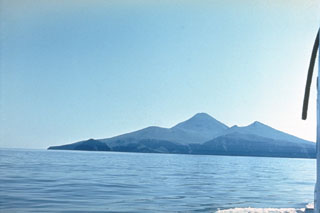Report on Chirpoi (Russia) — 2 March-8 March 2016
Smithsonian Institution / US Geological Survey
Weekly Volcanic Activity Report, 2 March-8 March 2016
Managing Editor: Sally Sennert.
Please cite this report as:
Global Volcanism Program, 2016. Report on Chirpoi (Russia) (Sennert, S, ed.). Weekly Volcanic Activity Report, 2 March-8 March 2016. Smithsonian Institution and US Geological Survey.
Chirpoi
Russia
46.532°N, 150.871°E; summit elev. 742 m
All times are local (unless otherwise noted)
Based on satellite images, the Tokyo VAAC reported that on 6 March a possible eruption at Chirpoi may have produced an ash plume that rose to an altitude of 6.1 km (20,000 ft) a.s.l. and drifted E. A subsequent image the next day showed that any ash had dissipated.
Geological Summary. Chirpoi, a small island lying between the larger islands of Simushir and Urup, contains a half dozen volcanic edifices constructed within an 8-9 km wide, partially submerged caldera. The southern rim of the caldera is exposed on nearby Brat Chirpoev Island. The symmetrical Cherny volcano, which forms the central cone of the island, erupted twice during the 18th and 19th centuries. The youngest volcano, Snow, originated between 1770 and 1810. It is composed almost entirely of lava flows, many of which have reached the sea on the southern coast. No recorded eruptions are known from Brat Chirpoev, but its youthful morphology suggests recent Strombolian activity.

